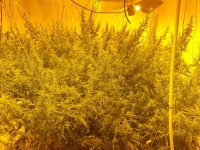CannaRed
Cannabinerd
light is divided into three classifications called UV-A, UV-B, and UV-C.
Standard window glass, according to the International Ultraviolet Association, will allow UV-A to pass through while almost 100% of the UV-B and UV-C light is blocked.
https://hps.org/publicinformation/ate/q12082.html
UV-A radiation (from 315 to 420 nm) - Barely visible to the human eye, UV-A has the longest wavelength, is the least harmful to the human eye and is the most efficient. Most of the UV-A radiation emitted from the sun passes through the ozone layer and, thus, it is the most abundant form of ultraviolet
UV-B radiation (from 280nm to 315nm) - Primarily used within water sterilisation and decontamination, ensuring that mould and spores do not grow on plants. This is done by limiting bacteria in the water that moulds and spores would usually cling to and develop from.
UV-C radiation (typically below 280nm) - These wavelengths are usually filtered out through the ozone layer and are not usually present in sunlight. However, with the correct doses, UV-C can in fact increase the growth of plants. This wavelength ensures that pesticides and moulds that can be found during plant growth are limited/killed off, allowing the plant to flourish in optimal growing conditions.
The inclusion of UV-C within horticultural LED grow lights will enable plants to increase their height. However, you do need to be very careful with UV-C as typically, if overdosed, the plant can actually be stunted in growth. It is recommended a dose no higher than 15 minutes per week is applied. This is recommended for all plant growth (including trees)
https://www.rs-online.com/designspark/the-importance-of-ultraviolet-in-horticultural-lighting
Glass Greenhouses work very well.
I always heard that uvc was the most dangerous to humans. I remember them saying to remember uvB is Bad but uvC causes the big C cancer.
I need to figure out the wavelength of the UV light I put in my overflow Rez to cut down on slime.






 they look gorgeous...
they look gorgeous...




